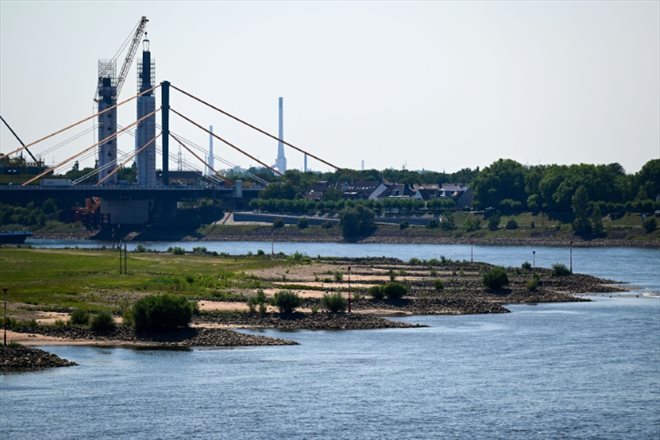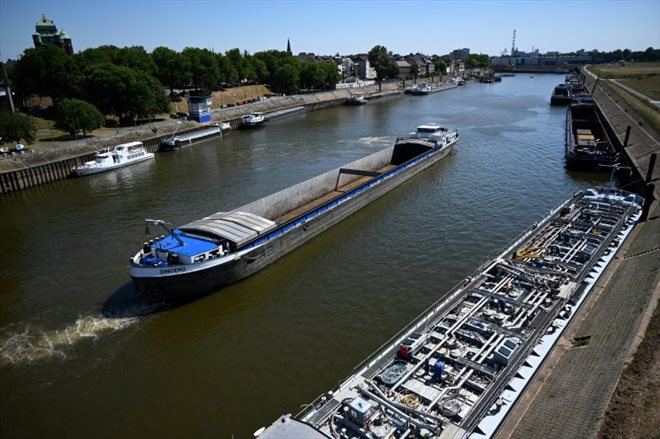An unloaded transport ship moves on the low waters of the Rhine in Duisburg, western Germany on August 9, 2022 (AFP/INA FASSBENDER)
In western Germany, the lack of water due to the peak summer heat is making the Rhine difficult to navigate, posing an additional threat to an already weakened German economy.
The prospect of a partial shutdown of river traffic on this river, one of the busiest in the world, is a new headache for German industry, already tested by the Russian gas crisis and soaring energy prices in the aftermath of the war in Ukraine.
Roberto Spranzi, boss of DTG, a shipping cooperative in the industrial city of Duisburg, says his fleet of more than 100 ships already has to limit its cargoes to avoid running aground.
“Right now we have to use three or four ships when normally we would only need one,” he told AFP.
Pointing to the worrying ebb at the entrance to the inner port of Duisburg, he notes that “currently it is at 1.70 meters. In theory, the normal water level is above two meters”.

A photo taken on August 9, 2022 shows the sandy banks of the Rhine at low water near the industrial city of Duisburg in western Germany (AFP/INA FASSBENDER)
“We supply the factories on the Rhine with raw materials. When this is no longer possible – or less often – this is also a threat to German industry,” he says.
Further up the river, at Kaub, about 30 kilometers south of Koblenz, the reference level should even drop below 40 cm by the end of the week, which would have the effect of compressing traffic even further.
– ‘Irregular operation’ –
Around 4% of freight is transported by sea in Germany, including on the Rhine, which originates in Switzerland and crosses several countries including France and Germany before flowing into the sea in the Netherlands.
The river has regained importance in recent months because, in particular to turn away from Russian gas on which it is dependent, Germany wants to turn more to coal.
However, the large power plants are mainly located around the Rhine, a key river for their supply.

An unloaded transport ship moves on the low waters of the Rhine in Duisburg, western Germany on August 9, 2022 (AFP/INA FASSBENDER)
Germany’s biggest companies have already warned that major disruptions to river traffic could deal a further blow to an economy already struggling with supplies.
The giant Uniper said the low level of the Rhine could lead to “irregular operation” of two of its coal-fired power stations in September. EnBW, which operates sites in the Baden-Württemberg region (southwest), also warned that coal deliveries could be limited.
The drop in the level of the Rhine has led to an “increase in transport costs per tonne”, warned the energy company, which already stockpiled coal as a precaution earlier this year.
“The low water level of the Rhine means that (…) important transport of petroleum products, diesel or heating fuel, cannot be ensured normally”, underlines Alexander von Gersdorff, spokesperson for the German trade association for energy and fuel industries.
– Risk of shortage –
As a result, several industrial heavyweights stationed along the Rhine, such as ThyssenKrupp or BASF, are expecting a possible slowdown in their activity.
The German chemicals group, which is headquartered in Ludwigshafen, south of the Kaub choke point, warned it could not rule out “cuts for specific units in the coming weeks”.
The decrease in freight on the Rhine thus adds to the disruption of the supply chain observed by the industry, accentuating the risk of shortages.
In Bavaria, a shortage of fuel at the pump has been attributed, among other factors, to the low level of the river.
The 2018 drought, which saw the benchmark depth of the Rhine at Kaub drop to 25 centimeters in October, cut German GDP by 0.2% that year, according to Deutsche Bank Research.
“The low levels came much earlier this time,” one of its economists Marc Schattenberg told AFP.
“If the problems we are seeing now last longer (than in 2018), the loss of economic value becomes that much more severe,” he says.
© 2022 AFP
Did you like this article ? Share it with your friends with the buttons below.




